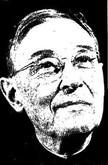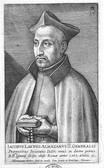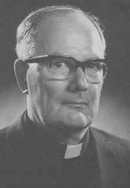Terms: A | B | C | D | E | F | G | H | I | J | K | L | M | N | O | P | Q | R | S | T | U | V | W | X | Y | Z
Jesuit Terms L
Terms L
- Laudato Deum
- Laudato Si'
- LaFarge, John
- Lainez, Diego
- Laity
- Land O' Lakes Conference
- LeMoyne, Simon
- Liberal Arts Tradition, Education in the
- Liberation Theology
- Life and work of Apostolic Women Religious
in the U.S. after Vatican II - Liturgy
- Liturgical Music
- Locatelli, Paul
- Lonergan, Bernard
- Lopez Quintanta, Amando
- Lopez y Lopez, Joaquin
- Loyola
Laudate Deum
An apostolic exhortation by Pope Francis as a follow up to Laudato Si', signed on October 4, 2023.
Pope Francis’ follow-up to Laudato Si, Laudate Deum (Praise God) was signed on October 4 (the Feast Day of St Francis of Assisi), 2023. It continues the call for “all people of good will,” especially those from the Western world, to mitigate the devastating effects of climate change.
Laudato Si'
Pope Francis' first original encyclical
Laudato Si,’ focuses on integral ecology - the inter-connected relationship between God, humans, and the Earth. It is addressed to "every person living on this planet." It translates from Italian to “Praise be to You” which is phrasing from the song Canticle of the Creatures written by St. Francis of Assisi. Signed on May 24, 2015.
LaFarge, John (1880-1963)
American Jesuit; editor, journalist, founder of the Catholic interracial movement in the U.S.
 Spent 15 years in pastoral ministry in the Jesuit rural missions of St. Mary's County, southern Maryland, largely among African Americans.
Spent 15 years in pastoral ministry in the Jesuit rural missions of St. Mary's County, southern Maryland, largely among African Americans.
From 1926 until his death, associate editor of America, the national Jesuit weekly review.
For more than 35 years, he carried on his long apostolate for interracial justice in the pages of America, on the lecture platform, and principally through the formation across the country of the Catholic Interracial Councils and their organ, the Interracial Review.
Besides numerous journal articles and reviews, his published works include Interracial Justice (1937), The Race Question and the Negro (1953), The Manner Is Ordinary, his autobiography (1954), and An American Amen (1958). Among his unpublished works was the encyclical condemning European (Italian and German) anti-Semitism which he had secretly drafted at the request of Pope Pius XI and which his successor, Pope Pius XII, chose not to publish.
Lainez, Diego (1512-1565)
Spanish Jesuit; one of first companions; second superior general
Of Jewish descent (his great-grandfather was a convert), Lainez was one of the great men of Catholic reform especially through his work as papal theologian at the Council of Trent (three sessions between 1545 and 1563). Two years after Ignatius' death, he was elected second superior general of the Society.
There is a biography by Joseph Fichter titled James Lainez, Jesuit (St. Louis: B. Herder, 1944).
The last name is sometimes spelled Laynez.
Laity
Lay person/lay people
The people of a religious faith as distinguished from its clergy; within Catholic circles, however, members of religious communities who are not ordained (i.e. "sisters" and "brothers") are often popularly associated with priests and bishops and not with lay people. (It would be more accurate to see them as neither, as having their own unique role and style of life; see "Religious Order/Religious Life."
The Second Vatican Council (1962-1965) understood the church inclusively—not just as hierarchy (bishops and pope) and clergy (priests and deacons) but as the whole people of God. It declared that all the baptized, by the very fact of their baptism, are called to holiness and to ministry.
Land O' Lakes Conference (1967)
Just a few years after the close of the Second Vatican Council, twenty-some leaders in American Catholic higher education [including Theodore Hesburgh of Notre Dame and Paul Reinert of St. Louis] met on two different occasions and produced what is now commonly referred to as the "Land O'Lakes Statement," after the Wisconsin location of their meeting. The statement was an important preparation for the worldwide conference "The Catholic University in the Modern World" held in Kinshasa, Congo, the following year. That conference issued a brief declaration, many points of which were taken from the Land O'Lakes statement. The two statements together informed the dialogue that ensued between American Catholic universities on the one hand and American bishops and the Vatican Congregation for Catholic Education on the other. This dialogue led gradually into the composition of various drafts of Pope John Paul II's apostolic constitution on Catholic universities, which was published in final form in August 1990: Ex Corde Ecclesiae ("From the Heart of the Church").
—(A Jesuit Education Reader, ed. George W. Traub [2008]).
LeMoyne, Simon (1604-1697)
French Jesuit; missioner to New France; peace negotiator
 Simon LeMoyne arrived in Quebec city in 1638 and soon went to Wendake (earlier called the Huron territory), where John de Brebeuf and other Jesuits and lay volunteers labored. He became proficient in the Wendat, Iroquois, and Algonquin languages. Indeed, among the 300 French Jesuits who would serve on the New France mission in the 17th and 18th centuries, he knew the native languages and the nuances of their oratory and diplomacy best (MacDonnell, Jesuit Family Album (1997).
Simon LeMoyne arrived in Quebec city in 1638 and soon went to Wendake (earlier called the Huron territory), where John de Brebeuf and other Jesuits and lay volunteers labored. He became proficient in the Wendat, Iroquois, and Algonquin languages. Indeed, among the 300 French Jesuits who would serve on the New France mission in the 17th and 18th centuries, he knew the native languages and the nuances of their oratory and diplomacy best (MacDonnell, Jesuit Family Album (1997).
LeMoyne survived the Mohawk destruction of the Wendat-French community (see "Brebeuf, John de") and went on to negotiate peace (1654) with another branch of the Five Nations (Iroquois), the Onondagas, near the site of present-day Syracuse, NY. When the New York Jesuits established a school in Syracuse in 1946, they named it LeMoyne College in honor of Simon LeMoyne.
Liberal Arts Tradition, Education in the
Liberal arts education (from the Latin liber meaning "free") means education that develops a truly free person, a person capable of living a life of wise and responsible citizenship. The concept goes back to classical Greece and Rome, but the content has changed somewhat over the centuries. Today such education would include study not just of humanities like philosophy, theology, literature, and history but also mathematics and the physical and social sciences. It is broad education that enables the learner to use different methods of knowing and to integrate different fields of knowledge. It is opposed to specialized education when that education is narrow and isolated from the larger world of a variety of disciplines and from human experience itself.
Christianity—especially but not exclusively Catholic Christianity—has had an important role to play in liberal arts education because of its conviction that faith and reason are not opposed to each other but complementary. Although professional higher education had its birth in Europe in the Christian Middle Ages, it was Muslim learning that brought the medieval university its foundational materials—classical Greek philosophy. In the Renaissance (15th and 16th centuries), the humanists, reacting to the university's focus on objective knowledge (which does not touch the whole person), promoted (classical) literature as a holistic teacher of good morals and responsible citizenship. Jesuit education, which began in the mid-16th century and soon became the first worldwide system of schools, drew on the best of both traditions, medieval and humanist. Closer to our own time and place, the (mostly Protestant) liberal arts college played a significant part in 19th- and early 20th-century America, although too many liberal arts colleges lost their heart when they let go of their religious character, moving from seminary to lay education.
In the 21st century, liberal arts education has come under attack as never before for being irrelevant to securing well-paying employment—a claim asserted but not clearly substantiated. In this era of the Great Recession with high unemployment in general and a serious decline in the kind of jobs that enabled people in the second half of the 20th century to enter the middle class and thrive, it is hard to justify an expensive education that offers seemingly vague goals like living wisely and justly and being able to adapt and change more than it does earning a good living right now. Still, the two goals are not mutually exclusive.
While U.S. higher education may be going through a decline in interest in liberal arts programs, European universities (and some elsewhere) seem to be establishing them in increasing numbers. But here it must be remembered that England, France, and Germany, for instance, with their traditional, highly selective, university-preparatory education programs (lycee, gymnasium), have long had liberal arts education (although only for the few) at the secondary level.
Liberation Theology
A movement within Latin American Catholic theology and spirituality since the 1950s and 60s that reads the Christian gospel from the standpoint of the poor. In Latin America there is hardly a middle class, and 5% of the population controls 80% of the wealth. Liberation theology has the gospel and the Hebrew prophets address the unjust social, economic, and political structures that keep the poor powerless. It claims that salvation is not just something that happens in the next life but that it must bring freedom and dignity and a fair share of the world's goods in this life to all, especially those who suffer oppression.
Some means of bringing about liberation are small Christian base communities where the gospel is applied to the life situation of the poor, programs that teach reading and in the process self-esteem, and labor organizing to secure more just wages. Such activities have stirred up the powerful to new levels of repression, including the killing of religious leaders who empower the poor.
The Vatican and the majority of local (Latin American) church leadership have been wary about liberation theology, seeing it as more Marxist than Christian and determined to uphold traditional church order (where many bishops come from and are aligned with the wealthy and powerful).
For a fuller statement, click here.
Life and Work of Apostolic Women Religious in the U.S. after Vatican II
Liturgy
From the Greek meaning "the peoples' work"
The term liturgy expresses an essential of worship as understood by the pioneers who prepared the way for the Vatican II document on the renewal of Catholic worship, namely, that it is not just something the priest does but rather is the work of the whole congregation, all the people. In this, it is consistent with the later council document on the church as not just the hierarchy but as the whole people of God.
The Catholic liturgy includes all the sacraments, but especially the Eucharist, commonly called the Mass, now seen actually to have two parts—the liturgy of the word and the liturgy of the Eucharist. In the former, people listen to God's word (scripture), what God has done for them; and in the latter people respond to God by joining Jesus in a great prayer of thanksgiving and praise, the Eucharistic Prayer.
Another part of liturgical worship is the Liturgy of the Hours, composed of psalms (and other songs) as well as readings from scripture and other religious writings. It is celebrated daily by the members of monastic communities (both women and men) at specified times throughout the day and night (the "hours"). Individual parts of it, for example evensong, are also celebrated, usually on an occasional basis, in some parish churches.
Liturgical Music
A New Kind for Catholics and Other Christians after Vatican II
In the time after the Second Vatican Council ("Vatican II") with its call for renewal of liturgy and worship, the repeated texts of the Mass were revised in a language and theology closer to that of ordinary speech. In keeping with these changes, a number of composers emerged with songs to accompany parts of this new liturgy. Instead of the old hymns in Latin or English translations from the Latin accompanied usually by the organ, these composers used words from the Bible, often enhancing the poetic quality of the scripture translation and setting them to music that could be described as "folk," played on piano and/or guitar (or flute and other instruments) rather than the organ. Over time, the result for many was that the word of God (scripture) came alive and "sang" in us, nourishing—without any effort on our part-our faith and prayer and life. Among the earliest and most famous of these composers were a group of Midwest Jesuits that called themselves the "St. Louis Jesuits": John Foley, Bob Dufford, Dan Schutte, Roc O'Connor, Tim Manion. Other composers followed—some of them equally gifted, some banal and without any sense of language.
Locatelli, Paul (1938-2010)
American Jesuit; president of Santa Clara University; leader for Jesuit higher ed
 After graduating in business from Santa Clara in 1960 and serving two years in the U.S. Army, Paul Locatelli entered the Jesuits in 1962. In addition to the regular Jesuit course of formation and education, he earned a doctorate in business (accountancy) from the University of Southern California. He joined the faculty of Santa Clara in 1974, was soon recognized as an outstanding teacher, and rose from dean of the Business School to academic vice president. In 1988 he became Santa Clara's 27th president. His 20 years in the role were marked by a rise in academic standards, prodigious fund raising, a 200% expansion of campus facilities, and a nearly ten-fold increase in the university's endowment.
After graduating in business from Santa Clara in 1960 and serving two years in the U.S. Army, Paul Locatelli entered the Jesuits in 1962. In addition to the regular Jesuit course of formation and education, he earned a doctorate in business (accountancy) from the University of Southern California. He joined the faculty of Santa Clara in 1974, was soon recognized as an outstanding teacher, and rose from dean of the Business School to academic vice president. In 1988 he became Santa Clara's 27th president. His 20 years in the role were marked by a rise in academic standards, prodigious fund raising, a 200% expansion of campus facilities, and a nearly ten-fold increase in the university's endowment.
Perhaps his greatest contribution came in his later years with his writing and speaking about the Jesuit Catholic mission in higher education. He is thought to have drafted the landmark address noted not just for content but for power of expression that Jesuit superior general Peter-Hans Kolvenbach gave to a national audience at Santa Clara in October 2000. He followed this up with his own talk on solidarity at John Carroll five years later. In 2007, Kolvenbach appointed him to coordinate Jesuit higher ed internationally, and only his premature death from pancreatic cancer halted what he might have accomplished here (in his last months he may have been the principal drafter of the address that the new superior general, Adolfo Nicolás, delivered to an international audience in Mexico City in April 2010).
>Kolvenbach, The Service of Faith and the Promotions of Justice in Jesuit Higher Education [a precis of the address can be found in Jesuit A to Z under Whole Persons of Solidarity for the Real World]
Nicolás, Depth, Universality, and Learned Ministry: Challenges to Jesuit Higher Education Today
Back to top
Lonergan, Bernard (1904-1984)
Canadian Jesuit; philosopher, theologian, interdisciplinary scholar of "method."
Concerned with the crisis caused by Christianity's difficulty in making the transition to modern society and culture ("Theology has somehow to mediate God's meaning into the whole of human affairs").
Inspired by what Thomas Aquinas did for Christianity in somewhat similar circumstances in the 13th century.
Professor of theology at Jesuit theologates in Montreal and Toronto (Insight: A Study of Human Understanding [1959]), Rome, again Toronto (Method in Theology [1972]), and finally at Boston College (work on an economics neither capitalist nor Marxist).
Conducted a now-famous Institute in the Philosophy of Education at Xavier University in August 1959.
The University of Toronto Press is gradually issuing the Collected Works in 20 volumes.
López Quintana, Amando (1936-1989)
López y López, Joaquín (1918-1989)
Loyola
The House of Loyola's coat of arms
 Loyola is a town in the Basque Country of northeastern Spain, where Ignatius (of Loyola) was born and raised. The name Loyola may be derived from the Spanish Lobo-y-olla, meaning "wolf and kettle." This image is found carved in stone on the castle where Ignatius was raised. The image reflects a legend that the family prepared enough food to feed themselves and the wolves in the area. It has become a symbol of hospitality and generosity. The coat of arms of the House of Loyola is depicted in the crests of many universities and schools.
Loyola is a town in the Basque Country of northeastern Spain, where Ignatius (of Loyola) was born and raised. The name Loyola may be derived from the Spanish Lobo-y-olla, meaning "wolf and kettle." This image is found carved in stone on the castle where Ignatius was raised. The image reflects a legend that the family prepared enough food to feed themselves and the wolves in the area. It has become a symbol of hospitality and generosity. The coat of arms of the House of Loyola is depicted in the crests of many universities and schools.
JESUIT A TO Z: An expanded version of the publication "Do You Speak Ignatian?"


